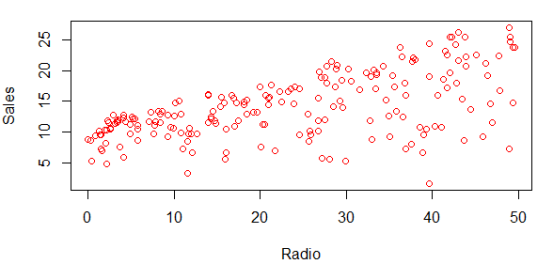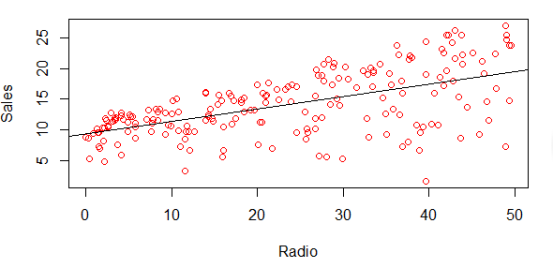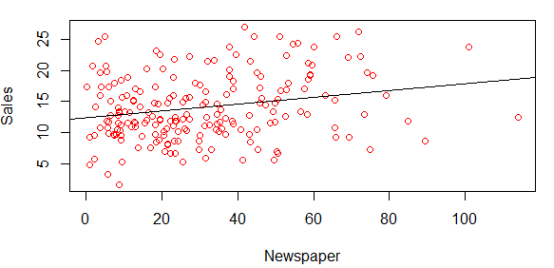使用R语言预测产品销量
使用R语言预测产品销量
通过不同的广告投入,预测产品的销量。因为响应变量销量是一个连续的值,所以这个问题是一个回归问题。数据集共有200个观测值,每一组观测值对应一种市场情况。
数据特征
- TV:对于一个给定市场的单一产品,用于电视上的广告费用(以千为单位)
- Radio:用于广告媒体上投资的广告费用
- Newspaper:用于报纸媒体上的广告费用
响应
- Sales:对应产品的销量
加载数据
> data <- read.csv("http://www-bcf.usc.edu/~gareth/ISL/Advertising.csv",colClasses=c("NULL",NA,NA,NA,NA)) > head(data) TV Radio Newspaper Sales 1 230.1 37.8 69.2 22.1 2 44.5 39.3 45.1 10.4 3 17.2 45.9 69.3 9.3 4 151.5 41.3 58.5 18.5 5 180.8 10.8 58.4 12.9 6 8.7 48.9 75.0 7.2 # 显示Sales和TV的关系 > plot(data$TV, data$Sales, col="red", xlab='TV', ylab='sales')

# 用线性回归拟合Sales和TV广告的关系 > fit=lm(Sales~TV,data=data) # 查看估算出来的系数 > coef(fit) (Intercept) TV 7.03259355 0.04753664 # 显示拟合出来的模型的线 > abline(fit)

# 显示Sales和Radio的关系 > plot(data$Radio, data$Sales, col="red", xlab='Radio', ylab='Sales')

# 用线性回归拟合Sales和Radio广告的关系 > fit1=lm(Sales~Radio,data=data) # 查看估算出来的系数 > coef(fit1) (Intercept) Radio 9.3116381 0.2024958 # 显示拟合出来的模型的线 > abline(fit1)

# 显示Sales和Newspaper的关系 > plot(data$Newspaper, data$Sales, col="red", xlab='Radio', ylab='Sales')

# 用线性回归拟合Sales和Radio广告的关系 > fit2=lm(Sales~Newspaper,data=data) # 查看估算出来的系数 > coef(fit2) (Intercept) Newspaper 12.3514071 0.0546931 # 显示拟合出来的模型的线 > abline(fit2)

# 创建散点图矩阵 > pairs(~Sales+TV+Radio+Newspaper,data=data, main="Scatterplot Matrix")

第一行图形显示TV,Radio,Newspaper对Sales的影响。纵轴为Sales,横轴分别为TV,Radio,Newspaper。从图中可以看出,TV特征和销量是有比较强的线性关系的。
划分训练集和测试集
> trainRowCount <- floor(0.8 * nrow(data)) > set.seed(1) > trainIndex <- sample(1:nrow(data), trainRowCount) > train <- data[trainIndex,] > test <- data[-trainIndex,] > dim(data) [1] 200 4 > dim(train) [1] 160 4 > dim(test) [1] 40 4
拟合线性回归模型
> model <- lm(Sales~TV+Radio+Newspaper, data=train) > summary(model) Call: lm(formula = Sales ~ TV + Radio + Newspaper, data = train) Residuals: Min 1Q Median 3Q Max -8.7734 -0.9290 0.2475 1.2213 2.8971 Coefficients: Estimate Std. Error t value Pr(>|t|) (Intercept) 2.840243 0.353175 8.042 2.07e-13 *** TV 0.046178 0.001579 29.248 < 2e-16 *** Radio 0.189668 0.009582 19.795 < 2e-16 *** Newspaper -0.001156 0.006587 -0.176 0.861 --- Signif. codes: 0 ‘***’ 0.001 ‘**’ 0.01 ‘*’ 0.05 ‘.’ 0.1 ‘ ’ 1 Residual standard error: 1.745 on 156 degrees of freedom Multiple R-squared: 0.8983, Adjusted R-squared: 0.8963 F-statistic: 459.2 on 3 and 156 DF, p-value: < 2.2e-16
预测和计算均方根误差
> predictions <- predict(model, test) > mean((test["Sales"] - predictions)^2) [1] 2.050666
特征选择
在之前的各变量和销量之间关系中,我们看到Newspaper和销量之间的线性关系比较弱,并且上面模型中Newspaper的系数为负数,现在去掉这个特征,看看线性回归预测的结果的均方根误差。
> model1 <- lm(Sales~TV+Radio, data=train) > summary(model1) Call: lm(formula = Sales ~ TV + Radio, data = train) Residuals: Min 1Q Median 3Q Max -8.7434 -0.9121 0.2538 1.1900 2.9009 Coefficients: Estimate Std. Error t value Pr(>|t|) (Intercept) 2.821417 0.335455 8.411 2.35e-14 *** TV 0.046157 0.001569 29.412 < 2e-16 *** Radio 0.189132 0.009053 20.891 < 2e-16 *** --- Signif. codes: 0 ‘***’ 0.001 ‘**’ 0.01 ‘*’ 0.05 ‘.’ 0.1 ‘ ’ 1 Residual standard error: 1.74 on 157 degrees of freedom Multiple R-squared: 0.8983, Adjusted R-squared: 0.897 F-statistic: 693 on 2 and 157 DF, p-value: < 2.2e-16 > predictions1 <- predict(model1, test) > mean((test["Sales"] - predictions1)^2) [1] 2.050226
从上可以看到2.050226<2.050666,将Newspaper这个特征移除后,得到的均方根误差变小了,说明Newspaper不适合作为预测销量的特征,则去掉Newspaper特征后得到了新的模型。





